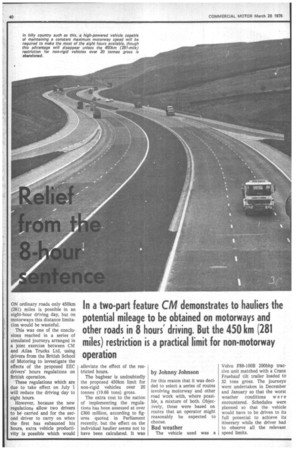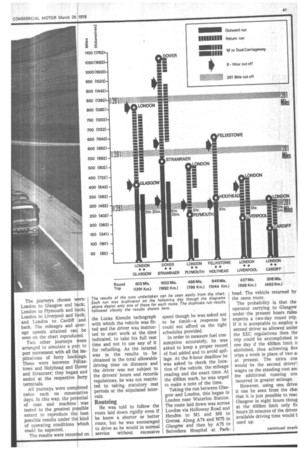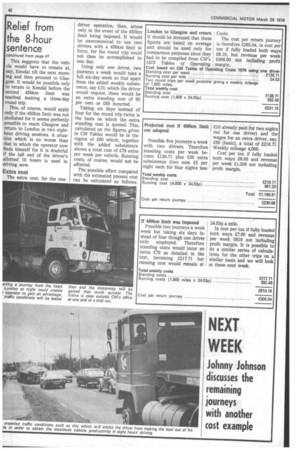In a two-part feature CM demonstrates to hauliers the
Page 42

Page 43

Page 44

If you've noticed an error in this article please click here to report it so we can fix it.
potential mileage to be obtained on motorways and other roads in 8 hours' driving. But the 450 km (281 miles) restriction is a practical limit for non-motorway operation
by Johnny Johnson
ON ordinary roads only 450km (281) miles is possible in an eight-hour driving day, but on motorways this distance limitation would be wasteful.
This was one of the conclusions reached in a series of simulated journeys arranged in a joint exercise between CM and Ailsa Trucks Ltd, using drivers from the British School of Motoring to investigate the effects of the proposed EEC drivers' hours regulations on British operation.
These regulations which are due to take effect on July 1 will reduce the driving day to eight hours.
However, because the new regulations allow two drivers to be carried and for the second driver to carry on when the first has exhausted his hours, extra vehicle productivity is possible which would alleviate the effect of the restricted hours.
The bugbear is undoubtedly the proposed 450km limit for non-rigid vehicles over 20 tonnes (19.68 tons) gross.
The extra cost to the nation of implementing the regulations has been assessed at over £300 million, according to figures quoted in Parliament recently, but the effect on the individual haulier seems not to have been calculated. It was for this reason that it was decided to select a series of routes involving motorway and other road work with, where possible, a mixture of both. Objec:ively, these were based on routes that an operator might reasonably be expected to choose.
Bad weather
The vehicle used was a Volvo F88-100B 290bhp tractive unit matched with a Crane Fruehauf tilt trailer loaded to 32 tons gross. The journeys were undertaken in December and January so that the worst weather conditions were encountered. Schedules were planned so that the vehicle would have to be driven to its full potential to achieve its itinerary while the driver had to observe all the relevant speed limits. The journeys chosen re: London to Glasgow and b ck; London to Plymouth and b ck; London to Liverpool and b ck; and London to Cardiff and back. The mileages and erage speeds attained can be seen on the chart reprodu Two other journeys ere arranged to simulate a pa t to port movement with all th plications of ferry book ngs. These were between F lixstowe and Holyhead and 0 over and Stranraer; they beg and ended at the respective etTy terminals.
All journeys were corn eted twice each on conse tive days. In this way, the pot ntial of man and machine was tested to the greatest po sible extent to reproduce the best possible results under th kind of operating conditions hich could be expected.
The results were reco ed on the Lucas Kienzle tachograph with which the vehicle was fitted and the driver was instructed to start work at the time indicated, to take his full rest time and not to use any of it for refuelling. As the interest was in the results to be obtained in the total allowable driving time on distance and the driver was not subject to the drivers' hours and records regulations, he was not restricted to taking statutory rest periods at the stipulated intervals.
Routeing
He was told to follow the route laid down rigidly even if he knew a shorter or better route, but he was encouraged to drive as he would in normal service without excessive speed though he was asked not to be timid—a response he could not afford on the tight schedules provided.
In order to measure fuel consumption accurately, he was asked to keep a proper record of fuel added and to avoid spillage. At the 8-hour deadline he was asked to check the location of the vehicle, the mileage reading and the exact time. At the 450km mark, he was urged to make a note of the time.
Taking the run between Glasgow and London, this began in London near Waterloo Station. The route laid down was across London via Holloway Road and Hendon to MI and M6 to Gretna. Along A74 and M75 to Glasgow and then by A75 to Belvedere Hospital at Park head. The vehicle returned by the same route.
The probability is that the operator carrying to Glasgow under the present hours rules expects a two-day round trip. If it is acceptable to employ a second driver as allowed under the EEC regulations then the trip could be accomplished in one day if the 450km limit iF abolished, thus achieving fivE trips a week in place of two a: at present. The extra cos would be the second driver': wages on the standing cost am the additional running cos incurred in greater mileage.
However, using one drive it can be seen from the chai that it is just possible to reac Glasgow in eight hours thoug at the 450km limit only fiv hours 20 minutes of the driver available driving time would t used up. • This suggests that the vehicle would have to remain at, say, Kendal till the next morning and then proceed to Glasgow. It would be possible only to return to Kendal before the second 450km limit was reached making a three-day round trip.
This, of course, would apply I only if the 450km limit was not abolished for it seems perfectly possible to reach Glasgow and return to London in two eighthour driving sessions, A situation which is no worse than that in which the operator now finds himself for it is doubtful if the tail end of the driver's allotted 10 hours is used in driving now.
Extra cost
The extra cost, for the one driver operation, then, arises only in the event of the 450km limit being imposed. It would be uneconomical to use two drivers with a 450km limit in force, for the round trip could not then be accomplished in one day.
Using only one driver, two journeys a week would take a full six-day week so that apart from the added weekly subsistence, say £10, which the driver would require, there would be an extra standing cost of 50 per cent or £69 incurred, Taking six days instead of four for the round trip twice is the basis on which the extra standing cost is quoted. This, calculated on the figures given in ,CM Tab/es would be in the region of £60 which, together with the added subsistence shows a total cost of £79 extra per week per vehicle. Running costs, of course, would not be affected.
The possible effect compared with the estimated present cost can be calculated as follows.
















































































































